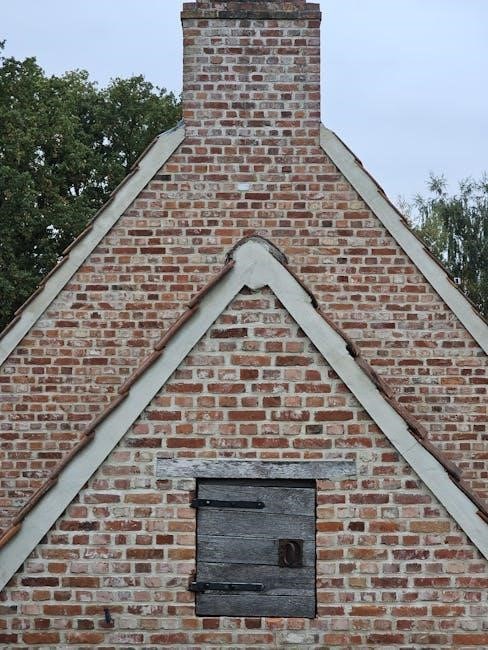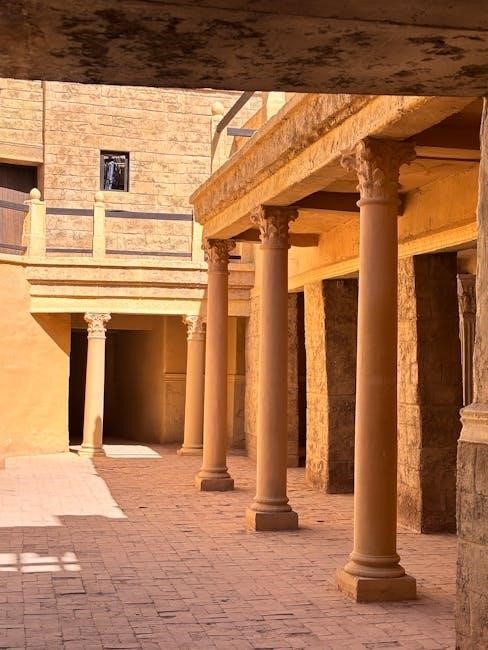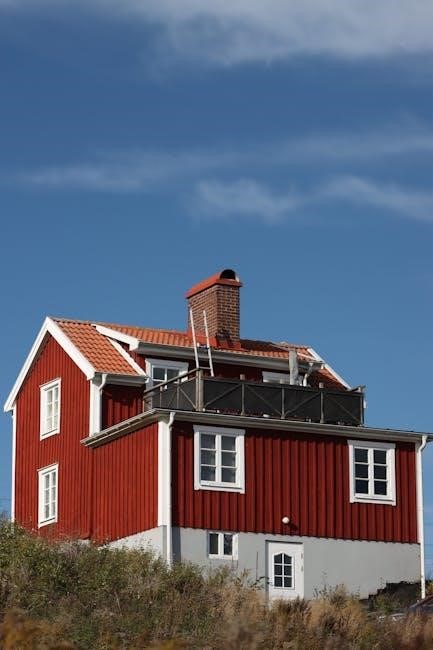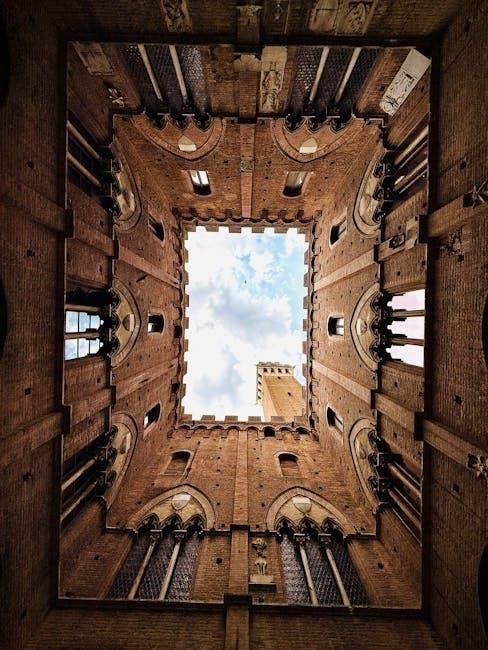Fiddler on the Roof is a beloved musical set in the small Jewish village of Anatevka, exploring themes of tradition, family, and cultural identity. Based on Sholem Aleichem’s stories, it follows Tevye, a poor milkman, as he navigates life’s challenges. The PDF script is widely available online, allowing readers to delve into its timeless narrative and iconic dialogue.
1.1 Historical Context of the Musical
Fiddler on the Roof is set in the early 20th century in the fictional Jewish village of Anatevka, under the rule of the Russian Empire. The musical reflects the socio-political tensions of the time, including the persecution of Jews and the eventual displacement of communities like Anatevka. Based on Sholem Aleichem’s stories, the play captures the struggles of Jewish life in Czarist Russia, where traditions were deeply rooted but increasingly threatened. The character of Tevye, a poor milkman, embodies the resilience of ordinary Jews striving to maintain their customs and faith amidst oppressive conditions. The historical backdrop of pogroms and the May Laws, which restricted Jewish settlements, adds depth to the narrative. The PDF script highlights these themes through dialogue and scenes, offering a vivid portrayal of a fading way of life.

1.2 Main Characters and Their Roles
The musical revolves around Tevye, a poor but spirited Jewish milkman, who narrates the story and often addresses the audience. His wife, Golde, is practical and strong-willed, managing the household and their five daughters. The eldest daughters—Tzeitel, Hodel, Chava, and Bielke—each play unique roles in exploring themes of love, tradition, and independence. Motel, a timid tailor, becomes Tzeitel’s husband, while Perchik, a radical teacher, marries Hodel. Fyedka, a non-Jewish Russian, challenges traditions by marrying Chava. Yente, the village matchmaker, adds humor and complexity to the story. These characters, along with the villagers of Anatevka, bring depth to the narrative. The PDF script provides detailed dialogue and interactions, showcasing their personalities and relationships, making it a rich resource for understanding the play’s dynamics.
1.3 Availability of the PDF Script Online

The Fiddler on the Roof script in PDF format is widely available online, providing easy access to the musical’s dialogue, songs, and stage directions. Websites like Scripts.com offer the complete script for review and discussion. This resource is invaluable for fans, students, and researchers, allowing them to explore the story’s depth, characters, and cultural themes. The PDF format ensures that the script is portable and easily shareable, making it a popular choice for theatrical productions and educational purposes. By downloading the script, readers can delve into the lives of Tevye, Golde, and their daughters, experiencing the balance between tradition and modernity. The availability of the PDF script has made Fiddler on the Roof more accessible than ever, ensuring its timeless story continues to resonate with audiences worldwide.
Key Themes in “Fiddler on the Roof”
Tradition, family, and cultural identity are central themes in the musical. The story explores the balance between adhering to customs and embracing change, highlighting the importance of heritage in a rapidly evolving world.
2.1 Tradition and Its Importance
Tradition is the cornerstone of life in Anatevka, as depicted in the Fiddler on the Roof script. The opening number, “Tradition,” sets the tone, emphasizing the importance of customs passed down through generations. Tevye, the protagonist, often reflects on tradition, using it as a guide for decisions, from marriage to religious practices. However, the story also explores the tension between adhering to tradition and embracing change. The arrival of modern ideas and external pressures forces the community to question their customs. Tradition serves as both a source of comfort and a point of conflict, highlighting its complex role in shaping identity. The script vividly portrays how tradition influences every aspect of life, from family dynamics to societal expectations, making it a central theme of the musical. The PDF script provides a detailed look at these moments, offering insight into the characters’ struggles and triumphs.
2.2 Family Dynamics and Relationships


Family dynamics are central to the narrative of Fiddler on the Roof, as seen in the PDF script. Tevye, the patriarch, navigates the challenges of maintaining tradition while addressing the desires of his family. His relationship with his wife, Golda, is built on mutual respect and shared values, though their interactions often reveal the complexities of marital life. The couple’s daughters, Tzeitel, Hodel, and Chava, each embody different approaches to marriage and independence, creating tension within the family. The matchmaker, Yente, adds another layer by attempting to arrange marriages according to tradition, while the daughters push for self-determination. These dynamics highlight the struggle between honoring family customs and embracing personal aspirations. The script explores these relationships in depth, showcasing how love, conflict, and compromise shape the family’s journey. The interplay between tradition and modernity is vividly portrayed through these interactions, making family dynamics a pivotal aspect of the story.

2.3 Cultural and Religious Identity
Cultural and religious identity are deeply intertwined in Fiddler on the Roof, as seen in the PDF script. The story revolves around Tevye, a devout Jewish milkman, and his family living in the small Russian village of Anatevka. Their lives are guided by Jewish traditions, customs, and religious practices, which serve as a source of comfort and identity. The community’s strong sense of cultural unity is reflected in their shared rituals, such as the Sabbath celebration and the traditional wedding ceremony. However, the encroaching influence of modernity and external pressures threaten their way of life, leading to a struggle to preserve their heritage. The musical explores the tension between maintaining cultural identity and adapting to change, highlighting the resilience of the Jewish people. Through its portrayal of faith, tradition, and community, the script underscores the importance of cultural and religious identity in the face of adversity.

The Script and Its Structure
The Fiddler on the Roof PDF script is divided into acts, each advancing the narrative through dialogue, songs, and dramatic scenes. The structure effectively balances humor and pathos, maintaining emotional depth throughout.
3.1 Act-by-Act Breakdown
The Fiddler on the Roof PDF script is structured into three acts, each progressing the story of Tevye and his family. Act 1 introduces Anatevka, the Jewish community, and Tevye’s struggles with tradition and his daughters’ marriages. Key scenes include the opening “Tradition” and the matchmaker’s visit. Act 2 explores the tensions between tradition and change, featuring the wedding of Tzeitel and Motel, as well as the arrival of Perchik, a radical teacher. Act 3 focuses on the expulsion of Jews from Anatevka, the family’s preparation to leave, and the emotional farewell. The acts seamlessly weave dialogue, songs, and dramatic moments, creating a cohesive narrative that balances humor and heartache. This structure highlights Tevye’s resilience and the enduring strength of family bonds amidst adversity.
3.2 Famous Scenes and Dialogues
The Fiddler on the Roof PDF script features several iconic scenes and dialogues that have become synonymous with the musical. One of the most memorable is the “To Life” toast scene, where Tevye and the villagers celebrate with lively music and dance. Another highlight is the dialogue between Tevye and Lazar Wolf as they negotiate Tzeitel’s marriage, showcasing Tevye’s wit and the societal norms of the time. The wedding scene, complete with the breaking of the glass, is both joyful and poignant; Additionally, the emotional confrontation between Tevye and Chava when she leaves home to marry Fyedka is a heart-wrenching moment. The script also includes the iconic “Sunrise, Sunset” scene, where Tevye and Golde reflect on their lives. These scenes and dialogues are masterfully crafted, blending humor, drama, and cultural depth, making the Fiddler on the Roof PDF script a timeless resource for theater enthusiasts.
3.3 Character Development in the Script
The Fiddler on the Roof PDF script masterfully portrays the evolution of its characters, blending humor, emotional depth, and cultural richness. Tevye, the protagonist, transitions from a traditional father to a man grappling with societal changes, showcasing his resilience and wit. Golde, his wife, evolves from a strong-willed matriarch to a woman confronting her vulnerabilities. Tzeitel, their eldest daughter, grows from a dutiful child to a woman defying tradition for love. Chava’s journey from rebellion to self-discovery highlights her struggle with identity and family expectations. Even minor characters, like the fiddler, symbolize the precarious balance between tradition and modernity. The script’s dialogue and scenes intricately reveal these transformations, making the characters relatable and memorable. This depth in character development is a key reason why the Fiddler on the Roof PDF script remains a cherished resource for actors and theater enthusiasts alike.

Musical Elements in the Play
The Fiddler on the Roof captivates audiences with its rich musical elements, blending traditional Jewish folk melodies with vibrant orchestration. Music drives the narrative, evokes emotion, and preserves cultural heritage.
4.1 Role of Music in Storytelling
Music plays a pivotal role in Fiddler on the Roof, serving as a narrative thread that binds the story together. It conveys emotions, highlights cultural traditions, and underscores key plot points. The iconic score, composed by Jerry Bock with lyrics by Sheldon Harnick, seamlessly integrates into the dialogue, creating a harmonious balance between speech and song. Songs like “If I Were a Rich Man” and “Sunrise, Sunset” not only advance the plot but also reveal character depths and societal themes. The orchestration reflects the Jewish folk tradition, adding authenticity to the storytelling. Music bridges the gap between the characters’ internal struggles and the audience’s emotional connection, making it an indispensable element of the play’s enduring success. This integration of music and narrative is a hallmark of the musical, as seen in the Fiddler on the Roof PDF script.
4.2 Iconic Songs from the Musical

The musical Fiddler on the Roof is renowned for its memorable and emotionally resonant songs, which are deeply intertwined with its storytelling. Iconic numbers like “To Life,” “If I Were a Rich Man,” and “Sunrise, Sunset” have become cultural touchstones. These songs not only showcase the characters’ inner lives but also reflect the broader themes of tradition, family, and identity. The Fiddler on the Roof PDF script includes the full lyrics to these beloved tracks, allowing readers to appreciate their poetic depth and emotional impact. The music, composed by Jerry Bock with lyrics by Sheldon Harnick, masterfully blends Jewish folk influences with modern musical theater, creating a timeless soundtrack. These iconic songs are central to the play’s enduring appeal and are beautifully preserved in the Fiddler on the Roof PDF script for audiences to cherish.

4.3 The Symbolism of the Fiddler
The fiddler in Fiddler on the Roof serves as a powerful symbol of resilience and balance in the face of uncertainty. Perched on the roof, the fiddler embodies the Jewish people’s struggle to maintain their traditions and identity amidst external pressures. The character of the fiddler is sparse in dialogue but rich in metaphorical significance, representing the fragile yet enduring nature of cultural heritage. The Fiddler on the Roof PDF script highlights this symbolism through its staging and descriptions, emphasizing the fiddler’s presence as a visual and emotional anchor. The fiddler’s music, though often interrupted, signifies the community’s ability to find joy and hope even in turbulent times. This poignant imagery is central to the play’s themes of tradition and survival, making the fiddler an indelible symbol in the story’s emotional landscape.
Legacy and Impact of “Fiddler on the Roof”
Fiddler on the Roof’s legacy endures through its timeless themes and influence on musical theatre, with its PDF script widely accessed and studied, ensuring continued performances and adaptations globally.
5.1 Influence on Musical Theatre
“Fiddler on the Roof” has profoundly shaped musical theatre by blending emotional storytelling with rich cultural themes. Its innovative use of music to convey complex emotions set a new standard for musicals. The show’s success paved the way for more nuanced, character-driven stories in theatre. Many modern musicals, such as “Les Misérables” and “The Producers,” draw inspiration from its storytelling techniques. The availability of the PDF script has further cemented its influence, allowing educators and performers to study its structure and adapt it for new audiences. This timeless musical continues to inspire creators, ensuring its legacy endures in the world of theatre.
5.2 Reasons for Its Enduring Popularity
The enduring popularity of “Fiddler on the Roof” stems from its universal themes and relatable storytelling. The musical masterfully blends humor, drama, and music, creating a deeply emotional connection with audiences. Its exploration of family, tradition, and identity resonates across cultures, making it a timeless classic. The well-crafted characters, particularly Tevye, offer complexity and depth, while the iconic songs, such as “If I Were a Rich Man” and “Sunrise, Sunset,” have become ingrained in popular culture. Additionally, the musical’s historical context and portrayal of the Jewish experience provide a unique lens for understanding cultural resilience. The availability of the PDF script has also made it accessible for schools, theatres, and enthusiasts, ensuring its continued relevance and adaptation. These factors combined have solidified its place as one of the most beloved musicals of all time.
5.3 Availability of the Script in PDF Format
The “Fiddler on the Roof” script in PDF format is widely accessible for educational and theatrical purposes. Official sources, such as the musical’s licensing companies or authorized publishers, provide legal downloads for a fee. Additionally, many libraries and educational institutions offer access to the script through their databases. The PDF format allows for easy reading and printing, making it convenient for study or production planning. However, it’s important to ensure that any download or use complies with copyright laws. The availability of the script in PDF has made it easier for fans, students, and theatre groups to engage with the material. This accessibility has contributed to the musical’s enduring popularity, as it enables new generations to explore and perform this beloved story.